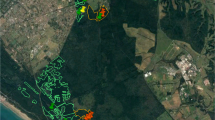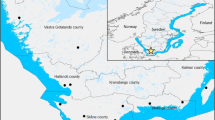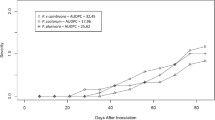Abstract
Phytophthora plurivora and other Phytophthora species are known to be serious pathogens of forest trees. Little is known, however, about the presence of P. plurivora in Polish oak forests and their role in oak decline. The aims of this study were to identify P. plurivora in healthy and declining Quercus robur stands in southern Poland and to demonstrate the relationship between different site factors and the occurrence of P. plurivora. In addition, the virulence of P. plurivora and other Phytophthora species was evaluated through inoculations using 2-year-old oak seedlings. Rhizosphere soil was investigated from 39 oak stands representing different healthy tree statuses. The morphology and DNA sequences of the internal transcribed spacer regions (ITS) of the ribosomal DNA and the mitochondrial cox1 gene were used for identifications. P. plurivora, an oak fine root pathogen, was isolated from rhizosphere soil samples in 6 out of 39 stands. Additionally, Phytophthora cambivora, Phytophthora polonica and Phytophthora rosacearum-like were also obtained from several stands. The results showed a significant association between the presence of P. plurivora and the health status of oak trees. Similar relationships were also observed for all identified Phytophthora species. In addition, there was evidence for a connection between the presence of all identified Phytophthora species and some site conditions. Phytophthora spp. occurred more frequently in declining stands and in silt loam and sandy loam soils with pH ≥ 3.66. P. plurivora and P. cambivora were the only species capable of killing whole plants, producing extensive necrosis on seedling stems.



Similar content being viewed by others
References
Balcì Y, Halmschlager E (2003a) Incidence of Phytophthora species in oak forests in Austria and their possible involvement in oak decline. For Pathol 33:157–74
Balcì Y, Halmschlager E (2003b) Phytophthora species in oak ecosystems in Turkey and their association with declining oak trees. Plant Pathol 52:694–702
Belbahri L, Moralejo E, Calmin G, Oszako T, Garcıa JA, Descals E, Lefort F (2006) Phytophthora polonica, a new species isolated from declining Alnus glutinosa stands in Poland. FEMS Microb Lett 261:165–174
Brasier CM, Robredo F, Ferraz JFP (1993) Evidence for Phytophthora cinnamomi involvement in Iberian oak decline. Plant Pathol 42:140–145
Brasier CM, Cooke DEL, Duncan JM, Hansen EM (2003) Multiple new phenotypic taxa from trees and riparian ecosystems in Phytophthora gonapodyides–P. megasperma ITS Clade 6, which tend to be high-temperature tolerant and either inbreeding or sterile. Mycol Res 107:277–290
Camy C, Delatour C, Marçais B (2003) Relationships between soil factors, Quercus robur health, Collybia fusipes root infection and Phytophthora presence. Ann For Sci 60:419–426
Cordier T, Belbahri L, Calmin G, Oszako T, Nowakowska J, Lefort F (2009) Emerging Phytophthora and Pythium species in Polish declining forests. Established and emerging Phytophthora: increasing threats to woodland and forest ecosystems in Europe. First working groups meeting April 16-19, 2009, Nový Smokovec, Slovakia. Poster
Erwin DC, Ribeiro OK (1996) Phytophthora diseases-worldwide. APS Press, St. Paul
Gallego FJ, Perez de Algaba A, Fernandez-Escobar R (1999) Etiology of oak decline in Spain. Eur J For Pathol 29:17–27
Gardes M, Bruns TD (1993) ITS primers with enhanced specificity for basidiomycetes: application to the identification of mycorrhizae and rusts. Mol Ecol 2:113–118
Guindon S, Dufayard JF, Lefort V, Anisimova M, Hordijk W, Gascuel O (2010) New algorithms and methods to estimate maximum-likelihood phylogenies: assessing the performance of PhyML 3.0. Syst Biol 59:307–321
Hansen EM, Delatour C (1999) Phytophthora species in oak forests of north-east France. Ann Sci For 56:539–547
Hansen EM, Wilcox WF, Reeser PW, Sutton W (2009) Phytophthora rosacearum and P. sansomeana, new species segregated from the Phytophthora megasperma “complex”. Mycologia 101:129–135
Hausendorff E (1940) Frostscha¨den an Eichen. Aus der Geschichte des Forstamtes Grimnitz ⁄ Uckermark. Z. Forst- u. Jagdwesen 72:3–35
Hubka V, Kolarik M (2012) β-tubulin paralogue tubC is frequently misidentified as the benA gene in Aspergillus section Nigri taxonomy: primer specificity testing and taxonomic consequences. Persoonia 29:1–10
Jönsson U (2004) Phytophthora species and oak decline—can a weak competitor cause significant root damage in a nonsterilized acidic forest soil? New Phytol 162:211–222
Jönsson U (2006) A conceptual model for the development of Phytophthora disease in Quercus robur. New Phytol 171:55–68
Jönsson U, Lundberg L, Sonesson K, Jung T (2003a) First records of soilborne Phytophthora species in Swedish oak forests. For Pathol 33:175–179
Jönsson U, Jung T, Rosengren U, Nihlgård B, Sonesson K (2003b) Pathogenicity of Swedish isolates of Phytophthora quercina to Quercus robur in two different soils. New Phytol 158:355–364
Jönsson U, Jung T, Sonesson K, Rosengren U (2005) Relationships between health of Quercus robur, occurrence of Phytophthora species and site conditions in southern Sweden. Plant Pathol 54:502–511
Jung T, Blaschke H (1996) Phytophthora root rot in declining forest trees. Phyton 36:95–101
Jung T, Burgess TI (2009) Re-evaluation of Phytophthora citricola isolates from multiple woody hosts in Europe and North America reveals a new species, Phytophthora plurivora sp. nov. Persoonia 22:95–110
Jung T, Nechwatal J (2008) Phytophthora gallica sp. nov., a new species from rhizosphere soil of declining oak and reed stands in France and Germany. Mycol Res 112:1195–1205
Jung T, Blaschke H, Neumann P (1996) Isolation, identification and pathogenicity of Phytophthora species from declining oak stands. Eur J For Pathol 26:253–272
Jung T, Cooke DEL, Blaschke H, Duncan JM, Osswald W (1999) Phytophthora quercina sp. nov., causing root rot of European oaks. Mycol Res 103:785–798
Jung T, Blaschke H, Obwald W (2000) Involvement of soilborne Phythophthora species in central European oak decline and the effect of site factors on the disease. Plant Pathol 49:706–718
Jung T, Hansen EM, Winton L, Osswald W, Delatour C (2002) Three new species of Phytophthora from European oak forests. Mycol Res 106:397–411
Jung T, Hudler GW, Jensen-Tracy SL, Griffiths HM, Fleischmann F, Oßwald W (2005) Involvement of Phytophthora species in the decline of European beech in Europe and the USA. Mycologist 19:159–166
Jung T, Stukely MJC, Hardy GE, St J, Paap T, White D, Dunstan WA, Burgess TI (2011) Multiple new Phytophthora species from ITS clade 6 associated with natural ecosystems in Australia: evolutionary and ecological implications. Persoonia 26:13–39
Katoh K, Toh H (2008) Recent developments in the MAFFT multiple sequence alignment program. Br Bioinforma 9:286–298
Kröber H (1985) Erfahrungen mit Phytophthora de Bary und Pythium Pringsheim. – Mitteilungen der Biologischen Bundesanstalt für Land- und Forstwirtschaft 225:1-175
Martin FN, Tooley PW (2003) Phylogenetic relationships among Phytophthora species inferred from sequence analysis of mitochondrially encoded cytochrome oxidase I and II genes. Mycologia 95:269–284
Moreira AC, Martins JMS (2005) Influence of site factors on the impact of Phytophthora cinnamomi in cork oak stands in Portugal. For Pathol 35:145–162
Mrázková M, Černý K, Tomšovský M, Strnadová V (2011) Phytophthora plurivora T. Jung & T. I. Burgess and other Phytophthora species causing important diseases of ericaceous plants in the Czech Republic. Plant Prot Sci 47(1):13–19
Mrázková M, Černý K, Tomšovský M, Strnadová V, Gregorová B, Holub V, Pánek M, Havrdová L, Hejná M (2013) Occurrence of Phytophthora multivora and Phytophthora plurivora in the Czech Republic. Plant Prot Sci 49(4):155–164
Olejarski I, Kubiak K, Nowakowska J, Jung T, Oszako T (2012) The occurrence of Phytophthora species in European Ecological Network NATURA 2000 in Poland. The Sixth Meeting of the International Union of Forest Research Organizations IUFRO Working Party 7‐02‐09 Phytophthora in Forests and Natural Ecosystems Córdoba (Spain), 9th14th September 2012. Meeting Abstracts: 103
Orlikowski LB, Oszako T (2005) Phytophthora cambivora on Alnus glutinosa: isolation and colonization of plants. J Pl Prot Res 45(4):267–272
Orlikowski LB, Gabarkiewicz R, Skrzypczak C (1995) Phytophthora species in Polish ornamental nurseries. Isolation and identification of Phytophthora species. Phytopathol Pol 9:73–79
Orlikowski LB, Ptaszek M, Rodziewicz A, Nechwatal J, Thinggaard K, Jung T (2011) Phytophthora root and collar rot of mature Fraxinus excelsior in forest stands in Poland and Denmark. For Pathol 41:510–519
Orlikowski LB, Trzewik A, Ptaszek M, Orlikowska T (2012) Relationship between source of water, occurrence, and pathogenicity of Phytophthora plurivora. Acta Mycol 47(1):3–9
Oszako T (2007) Przyczyny masowego zamierania drzewostanów dębowych. Sylwan 6:62–72
Oszako T, Orlikowski LB (2005) Pierwsze dane o występowaniu Phytophthora cinnamomi na dębie szypułkowym w Polsce. Sylwan 10:47–53
Posada D (2008) jModelTest: Phylogenetic model averaging. Mol Biol Evolut 25:1253–1256
Rambaut A, Drummond AJ (2007) Tracer v1.4, Available from http://beast.bio.ed.ac.uk/Tracer
Robideau GP, De Cock AW, Coffey MD, Voglmayr H, Brouwer H, Bala K, Chitty DW, Désaulniers N, Eggertson QA, Gachon CM, Hu CH, Küpper FC, Rintoul TL, Sarhan E, Verstappen EC, Zhang Y, Bonants PJ, Ristaino JB, Lévesque CA (2011) DNA barcoding of oomycetes with cytochrome c oxidase subunit I and internal transcribed spacer. Mol Ecol Resour 11(6):1002–1011
Robin C, Desprez-Loustau ML, Capron G, Delatour C (1998) First record of Phytophthora cinnamomi on cork and holm oaks in France and evidence of pathogenicity. Ann Sci For 55:869–883
Ronquist F, Huelsenbeck JP (2003) MrBayes 3: Bayesian phylogenetic inference under mixed models. Bioinforma 19:1572–1574
Sánchez ME, Caetano P, Ferraz J, Trapero A (2002) Phytophthora disease of Quercus ilex in south-western Spain. For Pathol 32:5–18
Siwecki R, Ufnalski K (1998) Review of oak stand decline with special reference to the role of drought in Poland. Eur J For Pathol 28:99–112
Stamps DJ, Waterhouse GM, Newhook FJ, Hall GS (1990) Revised tubular key to the species of Phytophthora. Mycol Pap 162, 28 pp. Commonwealth Agricultural Bureau International Mycological Institute.
Stępniewska H, Dłuszyński J (2010) Incidence of Phytophthora cambivora in bleeding lesions on beech stems in selected forest stands in south-eastern Poland. Phytopathol Pol 56:39–51
Stępniewska H, Jankowiak R, Kolařik M (2008) First report on Phytophthora cambivora from an oak stand in Poland. Phytopathol Pol 50:85–86
Tarasiuk S, Szczepkowski A (2006) The health status of endangered oak stands in Poland. Acta Scientiarum Polonorum Silvarum Colendarum Ratio et Industria Lignaria 5(1):91–106
Thomas F, Blank R, Hartmann G (2002) Abiotic and biotic factors their interactions as causes of oak decline in central Europe. Forest Pathol 32:277–307
Vettraino AM, Barzanti GP, Bianco MC, Ragazzi A, Capretti P, Paoletti E (2002) Occurrence of Phytophthora species in oak stands in Italy and their association with declining oak trees. For Pathol 32:19–28
Weiland JE, Nelson AH, Hudler GW (2010) Aggressiveness of Phytophthora cactorum, P. citricola I, and P. plurivora from European beech. Plant Dis 94:1009–1014
Zentmyer GA, Chen DW (1969) Production of sporangia by Phytophthora cinnamomi in pure culture. California Avocado Society, Yearbook 53:103–107
Acknowledgments
The study was carried out within the framework of statutory activities No. 3414/KFL.
Author information
Authors and Affiliations
Corresponding author
Rights and permissions
About this article
Cite this article
Jankowiak, R., Stępniewska, H., Bilański, P. et al. Occurrence of Phytophthora plurivora and other Phytophthora species in oak forests of southern Poland and their association with site conditions and the health status of trees. Folia Microbiol 59, 531–542 (2014). https://doi.org/10.1007/s12223-014-0331-5
Received:
Accepted:
Published:
Issue Date:
DOI: https://doi.org/10.1007/s12223-014-0331-5




